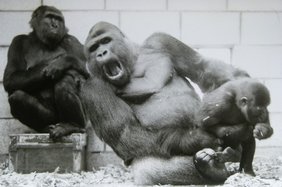The Impact of Kinship on Social Relationships between Immatures and the Silverback
Categories: Journal no. 69, Behaviour, Other countries, Western Lowland Gorilla
Western lowland gorillas usually live in one-male groups, consisting of one dominant male (a silverback), several females and their offspring. For immature gorillas, the mother is the most important social partner. As the immatures grow older, they usually shift their focus towards the resident silverback. Silverbacks are known for being very tolerant and for displaying affiliative behaviours towards the immatures. Immatures losing their fathers in the first year of life face a high risk of mortality.
One-male groups in western lowland gorillas are exposed to a relatively high risk of group disintegration after the death of the resident silverback. As a consequence, adult females and their offspring are forced to transfer to a new group. In the course of such an involuntary transfer, infanticide has been observed but also co-residence of the transferred immature with the new silverback. This raises the question about the quality of the social relationship between the silverback and co-resident immigrant immatures.
To answer this question, researchers from Kyoto University and the Institut de Recherche en Ecologie Tropicale examined one group of habituated western lowland gorillas in Moukalaba-Doudou National Park in Gabon. Nidai group had five members, including two adult females and their two infants, who were sired by the silverback of Nidai groups. After two neighbouring groups had disintegrated, Nidai group experienced an immigration of three adult females and their offspring, amongst others. Although the immigrant offspring were not sired by the silverback of Nidai group, no infanticide occurred. Amongst the "original" group members, there was one adult female, Randa, who had transferred from one of the neighbouring groups to Nidai group several years before their disintegration. Hence, Randa was an acquainted paternal kin to some of the immigrant immatures.
By observing the group during the years 2018 and 2019, the researchers found that the natal immatures, who were born in the group, spent more time in close proximity to the silverback than the immigrant ones. However, about one year after the transfer, the time spent in close proximity between the silverback and the immigrant immatures increased sharply. The silverback was the preferred social non-mother partner for the natal immatures, whereas some immigrant immatures preferred Randa as their social non-mother partner. This suggests that besides kinship familiarity plays an important role in influencing social relationships. There was no difference in the development of independence from the mother between the natal and the immigrant immature offspring, indicating that kinship with the silverback does not influence independence from the mother.
The proximity between the silverback and the immigrant immatures was usually initiated by the immatures. Additionally, the immigrant offspring spent more time close to the silverback than their mothers did. Despite the proximity, the silverback never displayed any agonistic behaviours towards the immigrant offspring. The researchers suggest that the tolerance towards the immigrant offspring shown by the silverback might be a reproductive strategy to enhance his own fitness.
Summary of this publication:
Tamura, M., Akomo Okoue, E. F., Mangama-Koumba, L. B., Ebang Ella Ghislain, W. & Mindonga-Nguelet, F. L. (2024): Does kinship with the silverback matter? Intragroup social relationships of immature wild western lowland gorillas after social upheaval. Primates 65, 397-410

